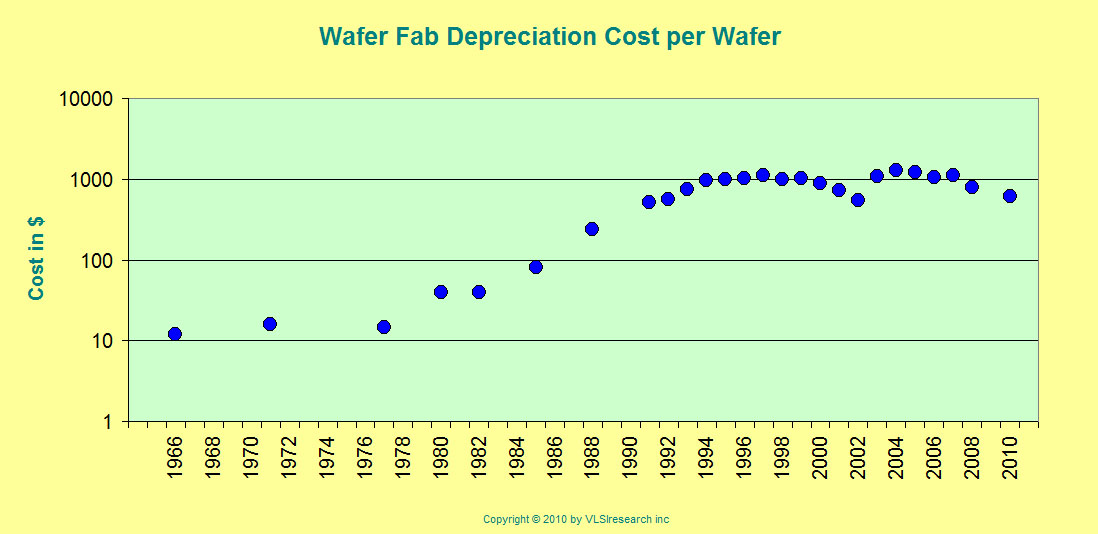The Chip Insider®
By G Dan Hutcheson
Copyright © VLSI Research Inc. All rights reserved.
February 12, 2010 – Semiconductor Wafer Fab Cost escalation a threat? Maxims applied: Intel’s new chip branding model
Reader Replies:
> At ISSCC, someone predicted that fabs would soon cost $100B. Do you agree (we don’t) and why is it that the academics keep throwing around these big numbers? <
— Of course I don’t agree. Look at the Toshiba flash fab from last week: $8.5B for 240K WSM. That works out to $3.5B for the standard 100K WSM memory megafab that people have been spending for ten years. In fact, measured by depreciation per wafer, fab costs have been flat for 20 years. Given the trend line, the sun will burn out before we hit the $100B fab unless someone is willing to build one that big, which could happen. Do note however that changes in wafer size are not factored in here, because we don’t measure fab capacity in area out, we measure it in wafers out. Factor area in and depreciation per square area is down.

As for why academics keep throwing these astronomical numbers around, it’s the result of the peer review process. Those doing peer review primarily vote on the value of the ideas in the article, not the data, and rarely check third-party economic data that is given as justification for the work. Once such data makes it into a peer reviewed paper, it gets sourced and resourced no matter how wrong it is. Worse, the more references a paper gets, the more validation it has and wrong data gains validation even though better data is out there. The other reason is that good data is very expensive and so academics rarely have access to it. It’s both easier and cheaper to source previous papers and in this way, myths like ever-rising fab costs grow. — Dan
Maxims Applied:
Intel’s new branding model
Intel’s taken a page out of the automotive branding book and in the process made it a whole lot easier to buy a PC, which is a big plus going into an upturn. I chided Intel for its confusing brands a couple of years ago, (March 6, 2008), writing that it was partly to blame for slower buying. I suggested they take an approach that made it clear to the buyer what was better, like BMW’s for example. That’s what they have done, with the Core i3, i5, and i7. Now it may seem similar to BMW, but you can also argue that the i3 pays homage to the landmark 386, and the i5 the Pentium, which was a quickly-created brand due to a judge’s ruling that you couldn’t trademark a number, i.e. 586. In any case, the new brand is easy to figure out: The Core i3 is a good processor, the Core i5 is better, and the Core i7 is best.
Better yet, they have also fixed the problem going forward, as these brands won’t change with the progression of Moore’s Law, which was another complaint of mine. The Core i series will be updated using model years, like cars. So a 2011 i5 will be better than the 2010 i5, but it will still be the mid-range of the Core i series. This way they take the mind numbing branding confusion wrought by Moore’s Law out of the equation. This is going to make it so much easier for consumers, which will inevitably help PC sales and drive the forecast. So, Thank You Intel. — Dan